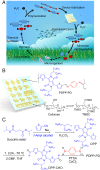Biocompatible and totally disintegrable semiconducting polymer for ultrathin and ultralightweight transient electronics
- PMID: 28461459
- PMCID: PMC5441761
- DOI: 10.1073/pnas.1701478114
Biocompatible and totally disintegrable semiconducting polymer for ultrathin and ultralightweight transient electronics
Abstract
Increasing performance demands and shorter use lifetimes of consumer electronics have resulted in the rapid growth of electronic waste. Currently, consumer electronics are typically made with nondecomposable, nonbiocompatible, and sometimes even toxic materials, leading to serious ecological challenges worldwide. Here, we report an example of totally disintegrable and biocompatible semiconducting polymers for thin-film transistors. The polymer consists of reversible imine bonds and building blocks that can be easily decomposed under mild acidic conditions. In addition, an ultrathin (800-nm) biodegradable cellulose substrate with high chemical and thermal stability is developed. Coupled with iron electrodes, we have successfully fabricated fully disintegrable and biocompatible polymer transistors. Furthermore, disintegrable and biocompatible pseudo-complementary metal-oxide-semiconductor (CMOS) flexible circuits are demonstrated. These flexible circuits are ultrathin (<1 μm) and ultralightweight (∼2 g/m2) with low operating voltage (4 V), yielding potential applications of these disintegrable semiconducting polymers in low-cost, biocompatible, and ultralightweight transient electronics.
Keywords: biodegradable materials; conjugated polymers; flexible electronics; organic electronics; thin-film transistors.
Conflict of interest statement
The authors declare no conflict of interest.
Figures





References
-
- Petti L, et al. Metal oxide semiconductor thin-film transistors for flexible electronics. Appl Phys Rev. 2016;3:021303.
-
- Hwang S-W, et al. 25th anniversary article: Materials for high-performance biodegradable semiconductor devices. Adv Mater. 2014;26:1992–2000. - PubMed
-
- Irimia-Vladu M. “Green” electronics: Biodegradable and biocompatible materials and devices for sustainable future. Chem Soc Rev. 2014;43:588–610. - PubMed
Publication types
MeSH terms
Substances
LinkOut - more resources
Full Text Sources
Other Literature Sources

